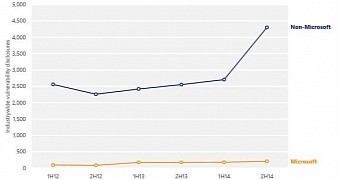Microsoft is often blamed for making devices vulnerable to cyberattacks, but statistics included in the Security Intelligence Report volume 18 show that apps developed by other companies are responsible to a greater extent for opening glitches that could be used to access your data.
The graph you see here shows the number of vulnerability disclosures for Microsoft and non-Microsoft products in the first and second half of 2014, with the software giant admitting that the overall count increased in both cases, but with a bigger percentage for the latter.
The number of disclosures for Microsoft software increased from 180 in the first half of the last year to 210 in the second, which represents a growth of 16.7 percent.
But when looking at non-Microsoft software that could make your devices vulnerable to attacks, Microsoft is no longer the one responsible for this.
Nearly 4,500 disclosures for third-parties
This graph shows that the number of vulnerabilities for non-Microsoft software jumped last year from approximately 2,700 in the first half to nearly 4,500 in the second, which, according to the software giant, is an increase of 93.8 percent.
“This increase is the result of a research project that uncovered SSL vulnerabilities in a large number of Android apps in the Google Play Store,” Microsoft says.
Microsoft has also revealed that the number of vulnerability disclosures in the core operating system increased 23.6 percent in the second half of the last year, while the number of disclosures in the case of OS applications dropped 22.8 percent.
Last but not least, disclosures of vulnerabilities in applications other than web browsers and OS applications increased 98.3 percent, thus accounting for no less than 76.5 percent of the overall count of vulnerabilities for the entire period.
Needless to say, Microsoft is working to make its software more secure, but as long as Windows remains the number one desktop operating system, its products designed for PCs will continue to be targeted by a big number of cyberattacks supposed to exploit vulnerabilities.

 14 DAY TRIAL //
14 DAY TRIAL //